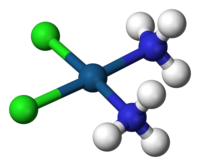
Photo from wikipedia
Abstract Thanks to their dimensional versatility and ability to form complexes, lanthanides are increasingly employed for the chiral sensing of biomolecules. In this work two sensing techniques based on the… Click to show full abstract
Abstract Thanks to their dimensional versatility and ability to form complexes, lanthanides are increasingly employed for the chiral sensing of biomolecules. In this work two sensing techniques based on the coordination chemistry of lanthanides are reviewed in detail. Circular dichroism (CD) spectroscopy exploits the coupling or binding of lanthanide complexes with chiral substrates, enabling their detection and study. This method is usually employed for the characterization of large biomolecules, i.e. DNA, proteins or amino acids, as well as anion-selective sensing and recognition. Circular polarized luminescence (CPL) can be efficiently employed for the detection of biological molecules when lanthanides are used as probes. In fact, their complexes result in great interest because their emission spectra can contain information about the symmetry and composition of the biomolecules.
Journal Title: Coordination Chemistry Reviews
Year Published: 2019
Link to full text (if available)
Share on Social Media: Sign Up to like & get
recommendations!